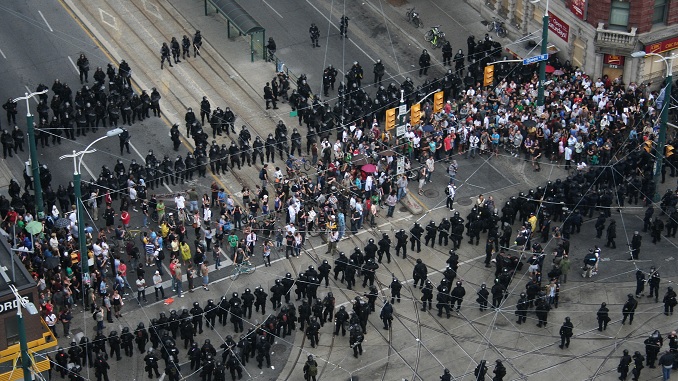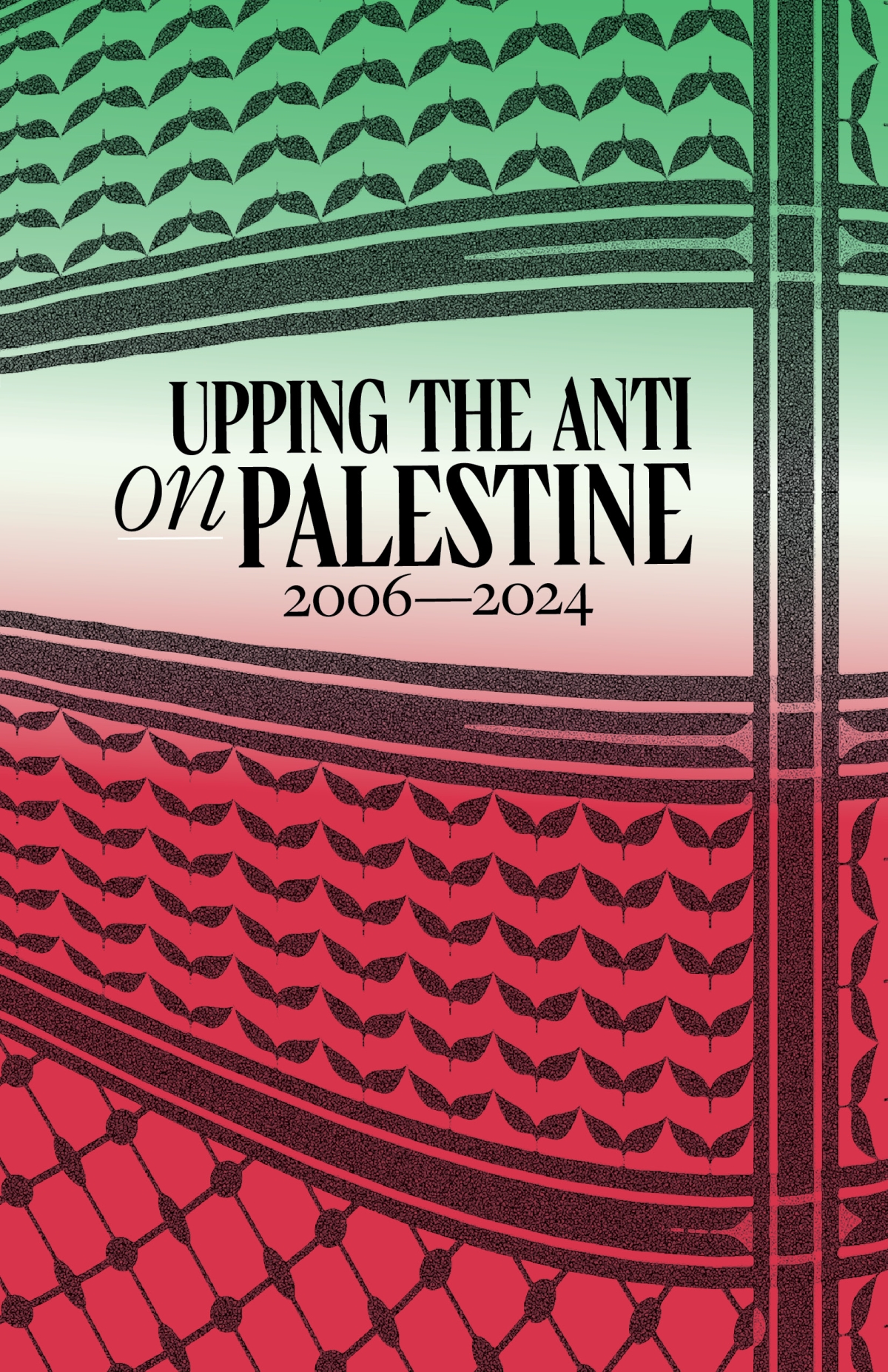Class Actions, Mass Movements: Policing, Politics, and the Toronto G20 Settlement Agreement

Toronto Police “kettling” civilians at a busy intersection. Photo credit: Jonas Naimark
A decade after the Toronto G20 summit, two mass class actions brought against the Toronto Police Service (TPS) by people caught up in kettles and/or imprisoned at a temporary detention center have been settled. After a detour to the Supreme Court of Canada – the TPS unsuccessfully attempted to have the lawsuits dismissed – a settlement which includes $16.5 million in financial compensation, expungement of arrest records, and “a public police acknowledgement regarding the mass arrests and the conditions in which protesters were detained” has been reached. The settlement still needs to be approved by Ontario’s superior court in October 2020, but there is no doubt that it is a victory – a rare example of police being held at least somewhat accountable in the aftermath of social movement repression. Beyond the TPS’s “acknowledging” of their misdeeds, however, it is worth thinking through the potential impact of this settlement – and especially the specifics of the TPS’s “commitment to detailed changes regarding policing of future public demonstrations” – on street protest and broader organizing in Toronto.
The settlement arrives at a strange moment. We just marked the 10th anniversary of the resistance against the G20 summit in the midst of both a pandemic and a whole new generation of uprisings that aim to call the very existence of police forces into question. Our political imagination has always gone far beyond what any extant court would ever order, but our current context lays the limitations of the policy reforms on offer here even more bare. The settlement includes a section on “future policing of public demonstrations” (see Schedule A); these measures cover a lot of the key protest policing issues raised by activists and advocates for decades, but only one outright commits to eliminating any police practices.
Despite the fact that one of the class actions was focused entirely on the tactic of ‘containment’ (better known as kettling), the settlement only states that containment will be “avoided unless it is necessary to prevent a substantial and imminent risk of harm to a person, all other less intrusive reasonable alternatives have been considered, and it is proportionate to the anticipated harm”. If kettling is used, there should be warnings, an opportunity to disperse, and an exit available, but only “where possible and appropriate”. These are enormous loopholes which do little to limit the use of kettling by the TPS in the future. In the days after the settlement agreement was released, activists and class members on social media discussed possible objections to this measure (and others) at the hearing next month. While there are obvious limitations to what the TPS will sign off on – the cops aren’t going to abolish themselves – kettling is a relatively new practice (it only emerged in Europe in the mid 1980s and was adopted by police forces in Canada and the US in the early 2000s) and a demand that it be removed wholesale from the TPS’s tactical repertoire is an arguably reasonable one.
Similarly, the agreement does not rule out the use of “temporary detention centers” during future mobilizations, but rather sets out considerations for their design and resourcing (including “meet provincial detention facility standards”). Given that the Prisoner Processing Center on Eastern Avenue was a chaotic shitshow of human rights abuses and Charter violations during the G20, this measure also seems ripe for objection. There is, unfortunately, no shortage of jail cells in the GTA; the TPS should not be handed a license to build temporary ones explicitly aimed at criminalizing resistance.
Only one measure imposes an actual – if still vague – prohibition on police: “Detainees are not to be prohibited by police from protesting peacefully upon release or required to refrain from protesting peacefully as a condition of their release (subject to any court order).” This is important, as repressive bail conditions (including blanket ‘no protest’ conditions that have been ruled unlawful by courts) have long been used to criminalize defendants – and limit their participation in movements – while they await trial (or are coerced or exhausted into guilty pleas). Activists have long known that the process of prosecution is itself a punishment; actual adoption of this measure by the TPS (in spirit as well as letter) could prove significant.
The bail policy stands out because the other “detention and arrest during demonstrations” measures remain far too imprecise. For example: “Planning for security operations is to address ways to avoid holding detainees in inappropriate conditions (e.g. extended periods in a parked police van or without bathroom access)”. One of the (many) problems here is the very structure and power of such ‘planning for security operations’: multi agency integration (the Integrated Security Unit for the G20 – carried over from the 2010 Vancouver Olympics – included 20,000 officers from the TPS as well as the RCMP, OPP, CSIS, and dozens of other agencies), huge budgets, surveillance and infiltration, intelligence gathering, etc. That protest policing street tactics are just the tip of the state repression iceberg is underscored by the settlement’s inclusion of “proactive policing” as a plus: “Measures such as de-escalation techniques, communication and proactive policing should be used, where appropriate.”
‘Where appropriate’ is, of course, up to the discretion of the police themselves, the very discretion that was central to the actions leading to these lawsuits and that undermines other measures cited in the settlement. Like the bail commitment, the measures regarding the use of ‘breach of peace’ (a Criminal Code provision that allows people to be held without charge to prevent unrest) to detain protesters rely on the language of ‘peaceful protest’: “The possibility that a detainee may join a peaceful protest if released is insufficient grounds for their continued detention by police.” Given that it is often police actions that escalate protests and that there is no definition of peaceful protest, the settlement leaves far too much leeway for continued detention of demonstrators (and unlucky bystanders) whatever the actual conditions on the ground.
Finally, it is worth noting that in the months and years after the G20, the class actions largely operated outside other movement defence structures and initiatives (e.g. the 247 Defendants’ Support Committee). On the one hand, this means that it is not clear what, if any, involvement class members, relevant organizations, and/or broader movements had in the drafting and negotiation of the protest policing policy measures found in the settlement. This is potentially a missed opportunity for not just the terms of the settlement, but also for growing movement knowledge about and capacity for proactive litigation. On the other hand, civil lawsuits that run along more participatory lines are enormously demanding of movement resources and time and have the potential to suck energy out of organizing and into courtrooms. Given the policy payoff here, limited engagement may have struck the right balance.
Irina Ceric is a long-time movement lawyer and was active in the Movement Defence Committee during the G20. She teaches criminology at Kwantlen Polytechnic University and is based in Toronto.

